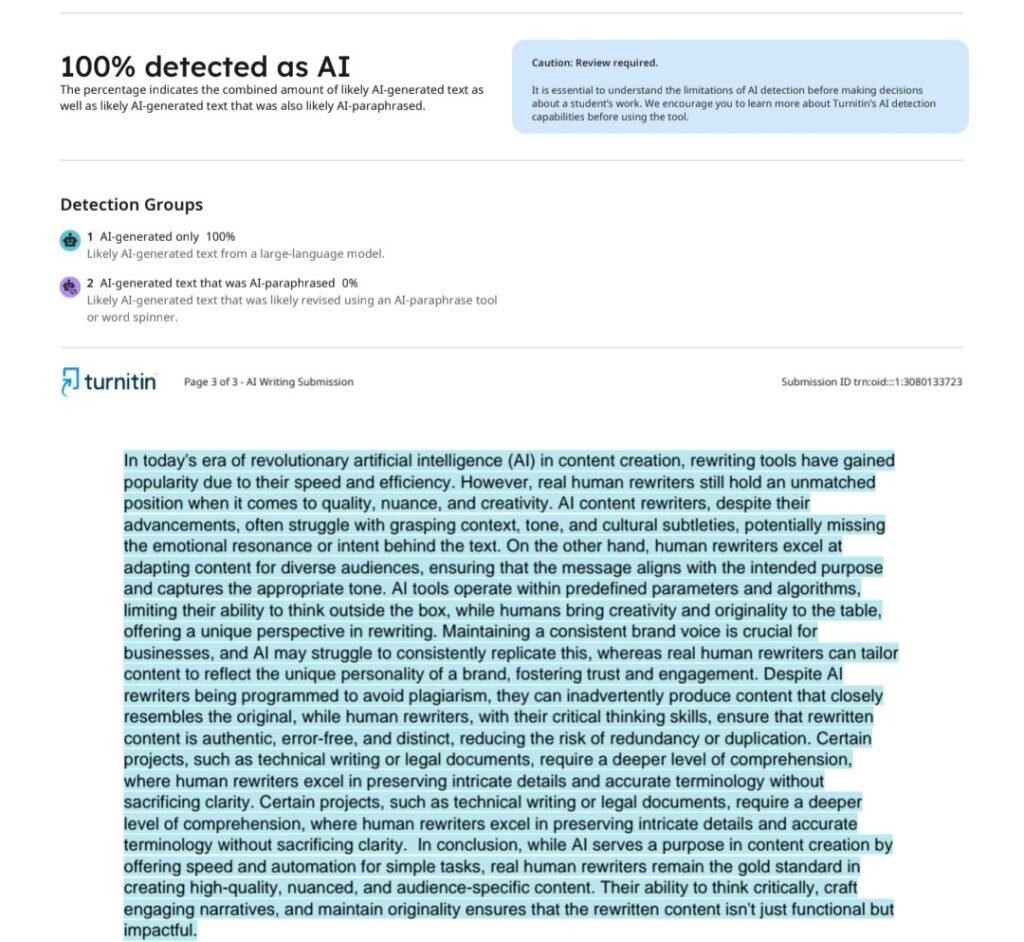Introduction
In this digital age, the reliance on artificial intelligence (AI) for content generation has surged, leading to the development of paragraph rewriter tools and plagiarism detectors. This experiment aims to demonstrate two primary assertions: firstly, that Originality AI’s plagiarism detection mechanisms are fundamentally flawed; and secondly, that paragraphs rewritten or humanized by Originality AI are still detected by traditional plagiarism detection tools like Turnitin. By rigorously examining the efficacy of these tools, we can better understand their limitations and the implications for professional and academic integrity.
The Originality AI Paragraph Rewriter Test Experiment
Step-by-Step Process
We will undertake the following steps:
1. Subscribing to Originality AI and Turnitin
We will begin by creating accounts on both platforms. Originality AI offers tools for rewriting AI texts and detecting AI-generated content, while Turnitin is widely recognized for its plagiarism detection capabilities. Ensure that you familiarize yourself with the functionalities and reporting formats of both tools.
2. Generating Pre-Humanized Content
We will then use ChatGPT to generate content by feeding it a specific prompt relevant to our content’s theme. For this experiment, we will ask chatgpt to write a 300-350 words article on Why Real Human Rewriters are the Best AI Content Rewriters.

This content, referred to as “pre-humanized,” will be a direct output of AI without any editing.
3. Testing AI Detection of Pre-Humanized Content
We will then submit the pre-humanized content to both Originality AI and Turnitin for analysis.

Evidently both platforms (Turnitin and Originality AI) have flagged the content as AI-generated.

4. Humanizing the AI-Generated Content
Now we will proceed to utilize Originality AI as the paragraph rewriter tool to “humanize” ChatGPT content. Notably, Originality AI prides itself not only as an AI-written text detector but also a complete content creation quality control tool. Our subsequent steps will check the veracity of these sentiments.

5. Testing Post-Humanized Content with Originality AI
We will then feed the post-humanized content back into Originality AI’s detection system.
As anticipated. the originality ai detectors give a result indicating 0% AI detection, suggesting that the content has been successfully altered to appear human-generated.
6. Testing Post-Humanized Content in Turnitin
Finally, we will submit the post-humanized content to Turnitin.

Evidently, despite the previous success in Originality AI, Turnitin seems to still identify the content as 100% AI-generated.
Experiment Results on the Reliability of OriginalityAI Paragraph Rewriter
- While the humanized content shows 0% AI detection in Originality AI, Turnitin still flags it as AI generated. This confirms the fact that traditional plagiarism detection tools have a different set of metrics that may capture the underlying AI signatures not recognized by Originality AI.
- The initial content fed into Originality AI was properly structured in format and flow. However, the paragraph rewriter jumbled everything in one paragraph that lacked coherence or structure.
CHECK SIMILAR EXPERIMENTS HERE:
- Can Turnitin Detect Undetectable Ai? [Screenshots]
- Can Turnitin Detect QuillBot? [Testing AI Paragraph Rewriter Against Turnitin]
- Can Turnitin Detect Humanize Ai? [AI Paragraph Rewriters Experiment With Screenshots]
Conclusions
Originality AI is not A Reliable Paragraph Rewriter
The experiment demonstrates that Originality AI, while effective in identifying AI-generated text under certain conditions, does not rewrite AI content to originality. A paragraph rewritten by Originality will still be flagged by Turnitin.
Flaws in Originality AI Detectors
The discrepancies between Originality AI and Turnitin highlight significant flaws in Originality AI’s detection systems. Indeed, Originality AI can be bypassed through strategic humanization techniques, raising questions about the reliability of such tools in maintaining academic integrity.
The Only Certain Way to Avoid AI Detection is Through Human Authorship
Ultimately, the experiment underscores that the most reliable method to bypass Turnitin and ensure originality is through genuine human authorship. Contrary to the human paraphrasing techniques that involve revamping content, the strategy used by AI tools typically involves rewriting, adding nuance, and making stylistic adjustments to produce post-humanized content. The objective is to disguise the original AI-generated patterns. However, as it has been proved, these tactics fail when placed against advanced AI detectors.
In summary, this experiment not only reveals the limitations of current AI detection tools, but also stresses the importance of human involvement in producing authentic professional and academic work.
Need your paragraph rewritten by real human rewriters, and not word spinners, to attain 100% originality?
